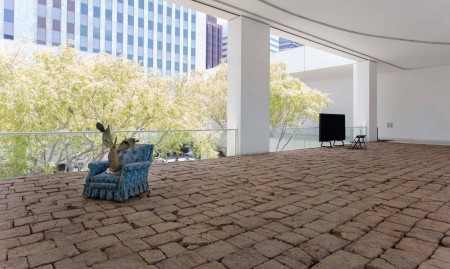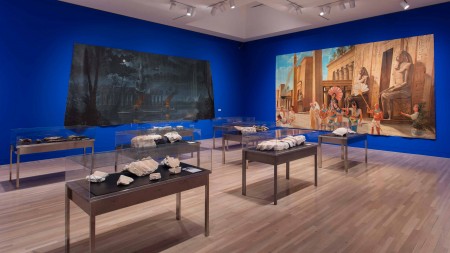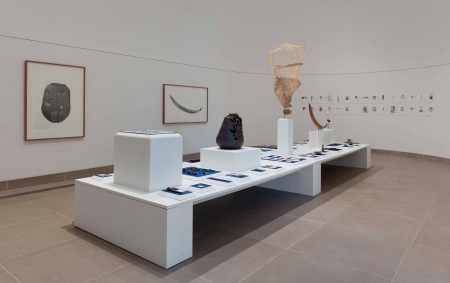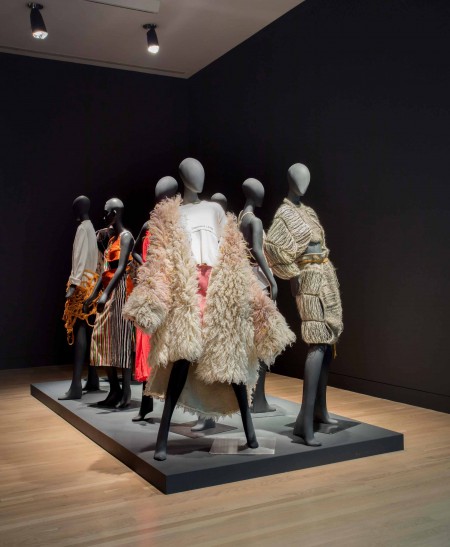This summer, Los Angeles hosted two biennials: the inaugural iteration of a city-sponsored public art biennial called “Current: L.A.,” and the Hammer Museum’s “Made in L.A.,” the third iteration of Los Angeles’ original biennial. In response to these exclusive exhibitions, two artists, aided by the sponsorship of various organizations, created a broadly inclusive, do-it-yourself exposition called “Maiden LA.” As an anagram and homophone of the museum biennial, “Maiden LA” sounds like a spoof, but is an event with a serious ethos that is interesting in the context of its relationship to that of “Made in L.A.”
“Made in L.A.” began in 2012 “with an emphasis on emerging and under-recognized artists,”[1] a stated focus that also extended to the 2016 version[2]. For this reason, the inclusion of blue-chip artist Sterling Ruby was controversial. Quoted in the LA Weekly, curator Hamza Walker justified Ruby’s inclusion with the idea that it had “been over seven years since he’d been seen in L.A.”[3]
Though focused on Los Angeles, the exhibition was remarkably diffuse, a distinguishing characteristic intended by its curators.
A Hammer Museum press release[4] states: “The exhibition addresses Los Angeles as a nexus of activity inseparable from the global network of art production, revealing how artists move fluidly between contexts and respond to their local conditions. The participating artists come from countries such as Australia, Brazil, Canada, Columbia [sic], Germany, Lebanon, Spain, and Switzerland, and disregard any pretense of a unifying regional aesthetic, sensibility, or identity that has tended to be historically associated with Los Angeles.”
Further underscoring this concept, Hamza Walker, who organized the show with Hammer Museum curator Aram Moshayedi, was not an Angeleno. At the time of the show, he was director of education and associate curator of the Renaissance Society in Chicago.
The idea of centering a show on the city, but disregarding “pretense of unifying regional aesthetic, sensibility, or identity … associated with Los Angeles” is interesting in its apparent passiveness as a theme, and timely given the city’s recent explosion as an international art hub. It’s also paradoxical, because educing the city’s artistic diversity, diffuseness, and connections to other places thus becomes a very strong unifying curatorial ideology.
This ideology was borne out in the content of much of the work on display. One of the most poignant examples was Tierra, Rafa Esparza’s captivating installation involving an expanse of adobe bricks covering a bridge that one could traverse in order to access another part of the exhibition. One had to walk on the bricks in order to closely apprehend odd items, like a cactus sitting in an easy chair, interspersed throughout the mud-brick field. From the origins of the clay from which the bricks were created, to the items situated amid the adobe expanse, the work was replete with back-stories and cultural symbolism relating to the region’s history. For instance, the artist had buried and later retrieved the items in the Chavez Ravine, a local canyon full of Mexican-American history and political controversy, where Esparza also obtained the mud for the bricks. Nevertheless, awareness of background intricacies was not necessary to appreciate the piece. The tenuousness of time and fragility of culture were palpable as one walked across the friable earthen floor and viewed the strange assemblages.

Rafa Esparza, “tierra”, 2016. Installation view, “Made in L.A. 2016: a, the, though, only”, June 12 – August 28, 2016, Hammer Museum, Los Angeles. Photo: Brian Forrest.
Esparza’s piece was one of several referencing archaeology. A question that recurred in various forms, either implicitly or explicitly, throughout the exhibition was: what roles do artist, curator, museum, and viewer play in interpretations and categorizations of artworks and other objects? Many projects played directly on the idea of the museum and objects therein. Daniel R. Small’s installation featured imitations of Egyptian artifacts. Some of these ersatz relics, used in a 1923 movie set, were excavated from the Guadalupe-Nipomo Dunes. Others had been removed from Luxor, an Egypt-themed Las Vegas casino. Small had borrowed the objects from public and private collections for use in his installation. Similarly, Gala Porras-Kim borrowed relics of uncertain date and provenance from the Fowler Museum, made a series of drawings and sculptures resembling them, and displayed with the relics.

Daniel R. Small. Installation view, “Made in L.A. 2016: a, the, though, only”, June 12 – August 28, 2016, Hammer Museum, Los Angeles. Photo: Brian Forrest.

Gala Porras-Kim. Installation view, “Made in L.A. 2016: a, the, though, only”, June 12 – August 28, 2016, Hammer Museum, Los Angeles. Photo: Brian Forrest.
Some artists’ work resembled objects from different cultures. For instance, Kenzi Shiokava’s totem sculptures referenced his Brazilian and Japanese identity. Some bore a similitude to African totems. As such, they appeared to transcend era and ethnography. Ceramic and papier-mâché sculptures by Huguette Caland evoked a tension between permanence and impermanence and the ability of ephemeral objects like newspaper to transcend their age. They, too, looked artifactual.

Kenzi Shiokava. Installation view, “Made in L.A. 2016: a, the, though, only”, June 12 – August 28, 2016, Hammer Museum, Los Angeles. Photo: Brian Forrest.
Other contributions, like Joel Holmberg’s meticulously rendered paintings affecting Web pages, invoked computer culture, questioning its relation to art history and the larger culture.
Some artworks did not exist physically. As opposed to projects by Small, Porras-Kim, et al, which treated of the museum as a repository of physical objects, this category of pieces negated the museum as a spatial venue. A tension between the museum’s physical location and ideological structure was evident throughout the show.
Whereas the 2012 and 2014 iterations of “Made in L.A.” showed 60 artists and 35 artists, respectively, the 2016 version featured only 26. Most of the artists were given vast amounts of space; individual bodies of work often took up entire rooms, operating as solo shows within the larger biennial. Several were traditional displays, like Rebecca Morris’ painting show, or Huguette Caland’s work shown as a retrospective. However, while this rendition of “Made in L.A.” featured fewer artists, it also employed a broader definition of art. The didactic wall label at the exhibition proudly proclaimed its amorphousness: “Made in L.A. 2016 focuses on artists from different disciplinary backgrounds, allowing individual projects and bodies of work to shape the overall exhibition. It features condensed monographic surveys, comprehensive displays of multi-year projects, and the premiere of new commissions from emerging artists, extending into such disciplines as dance, fashion, literature, music, and film.”
Cinematographer Arthur Jafa displayed vitrines of 3-ring binders full of collages he had created from 1990-2007. Didactic materials presented them as “an example of montage as defined by film theorists like Sergei Eisenstein and Dziga Vertov. These pairings form a visual hypothesis on the construction of subjectivity, and what Jafa has theorized as a decidedly black aesthetic.”[5] The collages were undeniably engaging, but their presentation seemed rather arbitrary. As only two pages of each binder were visible, only a relatively miniscule portion was on view, which seemed to classify them more as artifacts or sketchbooks than complete works intended for eventual display.

Arthur Jafa. Installation view, “Made in L.A. 2016: a, the, though, only”, June 12 – August 28, 2016, Hammer Museum, Los Angeles. Photo: Brian Forrest.
Other pieces fell squarely outside the realm of what would generally be considered art. Labor Link TV, a television show, was represented by a room full of cathode ray tubes, each playing a different video documenting union agitations. The TV program was started by artist Fred Londonier, but does that make its episodes art? In an Artillery Magazine[6] review, Anne Martens said of Jafa and Labor Link TV’s contributions, “I wouldn’t have considered them art had I not experienced them in a gallery.” This raises an interesting question: does the exhibition make the artwork, or does the artwork make the exhibition?

Labor Link TV. Installation view, “Made in L.A. 2016: a, the, though, only”, June 12 – August 28, 2016, Hammer Museum, Los Angeles. Photo: Brian Forrest.
The exhibition’s subtitle, “a, the, though, only,” a poem by Aram Saroyan, was billed as a piece in the show. According to the website, this was “a guide for thinking about the many different singularities and approaches represented by a venture of this nature. As such, the site of the subtitle becomes an integral part of the exhibition’s ever-expanding reach beyond the museum.”[7]
Some works completely overreached the show. Todd Gray contributed a performance in which he wore a friend’s clothing. “Throughout this exhibition, the piece’s presence is noted only through encounters one might have with the artist while going about one’s daily life or on the off-chance that Gray should visit the museum,” the exhibition website explains.[8] At the museum, only a descriptive wall label represented the piece. “His piece is not formally documented lest images be taken as the work itself,” it pronounces. But if Gray was not at the museum, and there was only an “off-chance” that he would visit, how is the piece part of the exhibition? Furthermore, why is there a wall label? The label serves as formal documentation that could be taken as the work itself just as images could. One wonders why Gray consented to participate. More importantly, one wonders why it should be considered part of the exhibition. Shana Nys Dambrot, in her ArtLtd. review,[9] called Gray’s provocative contribution–or lack thereof– “infuriating;” Martens referred to it as a “missed opportunity.” A piece that is not even apprehensible via the Internet or residual documentation becomes inaccessible, and thus practically irrelevant to museum visitors. Therefore, what purpose does it serve as a part of the exhibition?
Guthrie Lonergan’s work “exists on the Hammer Museum website and on the home screen for the on-site Public Recognition Award voting platform. … Ambient audio works produced by Lonergan in collaboration with Barefoot Music—a company known for television show themes for Top Chef and The Real Housewives—also appear throughout the museum.”[10]
Fashion design label Eckhaus Latta exhibited mannequins wearing costumes it had designed. “In addition to the clothing on view that surveys the brand’s past collections, Eckhaus Latta produced a promotional video, available only online, which exists exclusively in the realm of advertising,” says the website, echoing the wall label seen at the show.[11] Perhaps the design label’s “experimental approach to the production of clothing” belongs in the biennial, but what is the place of advertising? Didactic materials seem to hint at parallels between marketing and promotion of art with that of fashion, explaining that the “designs are also part of a network of distribution and circulation that includes the tools of marketing and promotion.” To what end are they included?

Eckhaus Latta. Installation view, “Made in L.A. 2016: a, the, though, only”, June 12 – August 28, 2016, Hammer Museum, Los Angeles. Photo: Brian Forrest.
Work accessible only online, not physically in the museum, stretches the definitions of a museum exhibit. Can a Web site be part of a museum show, by virtue of the fact that artist or curator says that it is? Evidently, it can. This principle renders the museum more of an ideological structure than a physical one.
In light of this, why does the museum need to exist as a single physical space? Why not exist only as a series of happenings?
Artists Molly Schulman and Salomeh Grace conceived of Maiden LA as “a county-wide network of ‘happenings’ … during the month of August 2016. The focus is to highlight Los Angeles as a vastly extensive and vibrant community, connecting these happenings throughout the region.”[12] In theory, this sounds very similar to the museum biennial’s endeavor. However, according to Schulman and Grace, anyone who submitted an event by the stated deadline was included on Maiden LA’s directory, which was available as a 29-page PDF, an online map, and a smartphone app.
Maiden LA’s website promoted “a call to assemble and connect any and all Los Angeles artists, curators, performers, collectives, etc., to host open studios, group shows, or self-initiated projects in both traditional and unconventional spaces.”[13] Schulman and Grace plan to make it a yearly event. Maiden LA is sponsored by several organizations, including Common Field, a non-profit that describes itself as a “visual arts organizing network connecting contemporary, experimental, noncommercial artist-run and artist centered spaces and initiatives.”[14] A bias is clear; however, the organizers apparently did not discriminate; shows at commercial galleries and venerable institutions like the Getty were listed along with artists’ performances, parties, and studio events. Mirroring the biennial, projects existing only online were included, too.
Is this not a more efficient, and more appropriate way of “revealing how artists move fluidly between contexts and respond to their local conditions”?[15]
Rafa Esparza cynically notes in an SRPC.org interview with Oscar Garza: “I love the diversity of cultural production in the city, and thinking about biennials as surveys, but also exhibitions that attempt to centralize a lot of cultural production, and do it within museums — this museum in particular being not as accessible to different art communities that are further east — [I wondered], Why does Los Angeles even need a biennial to begin with?”[16]
Esparza’s quote offers an interesting perspective under which to consider the show. Ultimately, the theme of “Made in L.A. 2016” is that of decentralization. Yet its attempt to “extend beyond the museum” renders it even less accessible, to use Esparza’s words, and implicitly provokes the question as to why a museum biennial exists.
Why does Los Angeles need a biennial? It doesn’t, nor does any other city or region. Biennials are never essential. However, they can invigorate a region and its art world. Whether or not one agrees with Walker and Moshayedi’s curatorial approach, it’s impossible to deny the fact that they produced a thought-provoking exhibition, the visible component of which was well worth seeing.
The plethora of questions raised by the exhibition makes Maiden LA all the more interesting as a contrasting model. Biennials are always controversial, and inevitably problematic. Inclusion in a biennial is tantamount to a major stamp of approval. This exhibition’s commercial-sounding title, “Made in L.A.,” highlights the authority implied by such an exhibition as arbiter of quality–it is after all L.A.’s primary museum biennial; and perhaps makes the disenfranchisement of un-included artists all the more palpable, as though the majority of artworks produced in L.A. don’t deserve to be officially branded as such. The further amorphous Maiden LA foils its exclusivity and provides an alternative platform to the rest of Los Angeles’ artists. Without it for contrast, analyzing “Made in L.A.” would not be so interesting. Yet without the museum biennial, Maiden LA would not exist. A biennial’s power can also be its weakness.
–Annabel Osberg
[1] https://hammer.ucla.edu/exhibitions/2012/made-in-la-2012/
[2] See section titled, “About Made In L.A.,” https://hammer.ucla.edu/made-in-la-2016/
[3] Catherine Wagley, The Hammer’s Made In L.A. Isn’t Really About Newness or L.A.–But That’s OK, LAWeekly.com, July 18,2016, http://www.laweekly.com/arts/the-hammers-made-in-la-isnt-really-about-newness-or-la-but-thats-ok-7103151
[4] “Hammer Museum Announces 26 Artists For Upcoming Biennial Made in LA 2016: a, the, though, only:” https://hammer.ucla.edu/fileadmin/media/Press_Releases/2016/Hammer_Made_in_LA_2016_Artist_Announcement.pdf
[5] https://hammer.ucla.edu/exhibitions/2016/made-in-la-2016/arthur-jafa/
[6] Anne Martens, “Labor of Love: Made in L.A.,” Artillery Magazine, September/October 2016, http://artillerymag.com/labor-love-made-l/
[7] https://hammer.ucla.edu/exhibitions/2016/made-in-la-2016/aram-saroyan/
[8] https://hammer.ucla.edu/exhibitions/2016/made-in-la-2016/todd-gray/
[9] Shana Nys Dambrot, “Made in L.A 2016: a, the, though, only,” art ltd., September/October 2016, http://www.artltdmag.com/index.php?subaction=showfull&id=1473541535&archive=&start_from=&ucat=28&
[10] https://hammer.ucla.edu/exhibitions/2016/made-in-la-2016/guthrie-lonergan/
[11] https://hammer.ucla.edu/smile/
[12] http://www.maiden.la/about/
[13] Ibid.
[14] http://commonfield.org/about
[15] https://hammer.ucla.edu/fileadmin/media/Press_Releases/2016/Hammer_Made_in_LA_2016_Artist_Announcement.pdf
[16] http://www.scpr.org/programs/the-frame/2016/06/09/49512/artist-rafa-esparza-moves-apprehension-and-earth-t/



